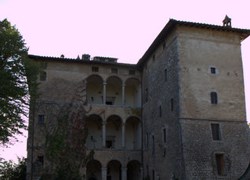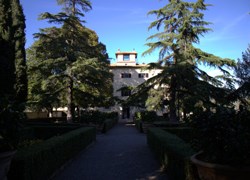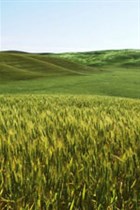We were in the Tuscan town of Volterra, lieu of the vampire coven in Stephanie Meyer's Twilight series, when we saw him. The boy's limbs were elongated and he was thin to the point of abstraction. We called him Stretch. He was also over 2000 years old and one of the most remarkable pieces of Etruscan sculpture we had ever seen.
Cast in bronze, Stretch, or Ombra della Sera (Shadow of the Night), is one of those pieces of art that completely defies its age. As contemporary as Giacometti, Stretch was the highlight of the Museo Etrusco Guarnacci, situated in the medieval ramparted hilltop town. And we were only on day two of a five-day self-drive through Tuscany and neighbouring Umbria.
My imagination was filled with visions of golden hills, dark cypresses, vineyards and bucolic olive groves when we set off from Rome up the coastal road to Tarquinia. By the end of the week, every picture postcard had been brought to life, every fantasy about "the good life" lived and every culinary yearning given appetite to.

Tarquinia has the best Estruscan necropolis in Italy, which is not to say that it's the most edifying visitor stop. The Estrucan tombs are small and roughly hewn, and the subterranean wall paintings are heavily faded. Despite starting our trip with lofty ideals, we soon dispensed with any pretensions to high culture and gave ourselves over willingly to the abandon of good cooking, lush scenery and fine weather instead.
Renowned for its art, history and evocative landscapes, Tuscany is a region where past and present meld in a most felicitous harmony. Fortified hill towns loom over rolling hamlets and farmhouses and no village feels more than two minutes from its neighbour. That sense of driving back through time into an age of watercolours was made real as we drove up to Relais La Suvera, the impossibly romantic setting for our first two nights' lodgings. Set on a wooded hill, La Suvera is an historic villa that was once a Papal palace. Now the erstwhile medieval fortress belongs to an aristocratic family and guests feels that sense of stately elegance at all touchpoints of the hospitality experience.

Suites are sumptuously appointed with claret-coloured velvets, four-poster beds and gilded touches. In fact, the whole room conjured a sort of Italianite royalty of the 1880s, a scheme that would work as well in winter as it felt refreshing in summer.
Apart from offering a spa, tennis court, on-site museum and heated outdoor swimming pool that would have made William Randolph Hearst envious for its collection of Renaissance statuary, Relais La Suvera's most appealing attraction is its restaurant. Named for the old olive mill it occupies, Oliviera's low wooden ceilings and gleaming terracotta floors offer a sense of rustic luxury, a promise that is fulfilled wholeheartedly in its epicurean menu. Throwing ourselves over to the chef's recommendations, we enjoyed a hearty vegetable and celery broth enriched with egg yolk, followed by steak in mustard sauce with creamy mille feuille potatoes. Cloud-scudded shadows brushed the topiaries with soft moonlight as we trundled to bed, almost too excited to fall asleep amidst such enchantment.

After a spectacular breakfast buffet of redolent berries, cool fruits, gorgeous prosciuttos, creamy cheeses and artisanal breads, we set off for further sightseeing in San Gimignano. The most storied of the walled hill towns, San Gimi has 13 towers, an architectural throwback to the status jostling of the town's noble families in the 12th and 13th centuries. After climbing to the heights of the Torre Grossa for an angel's eye view over the saffron-scented Tuscan hills and vineyards, we decamped to the Piazza della Cisterna. Here, in the village square built around the well in the centre of the old town, we gave ourselves over to the tranquillity of a cup of tea as warm as the morning sunlight.
The next day had us embarking on the definitive Tuscan road trip. For a region whose photo ops are so plenteous, the Le Crete road is first among equals. Located south of Siena, this day-long drive unshackles itself from the tourist drag and unfurls its landscapes like medieval banners. An area of rolling clay hills scored by steep ravines, Le Crete delivers cypress-edged pathways to easy-breathing country houses each mounting a small embankment to yield all-round views. Uncrowded and edifying, the route includes any number of quaint towns and far-flung abbeys reached by winding roads paintbrushed in summer foliage. One such monastery is the Abazzia di Monte Oliveto Maggiore, which sits at the bottom of a forested hill. Although we were too late to see the famed frescoes, we were just in time for lunch - a local specialty of sausage and white beans that still sings on my tongue.

We reached our second pied a terre, the Villa di Monte Solare, in the late afternoon. Located on a remote hillside above Lake Trasimeno, the villa is surrounded by groves of arcadian charm. Filled with sunlight and unpretentious ease, the villa is a soft landing after the studied luxe of other five-star establishments. Part of the warmth of one's reception - like staying with a dear aunt - is that the property is owner run and that sense of familial solicitousness imbues one's stay. That giving over to solicitousness is given its fullest expression in the villa's dining room. Here, on our first night we ate like prodigal sons: a creamy pecorino potage cut with pear chips, gnocchi bedded with catch of the day from the lake and finishing with coffee cheesecake hit with aniseed sauce. The food is so exuberantly good, so inventive in its combinations and collaborations, that we decided to eschew further touring and surrender to a cooking class in the morning with the chef. More than a culinary education, this was a lesson in the art of good living.
As we closed our Tuscan idyll, I thought back to Stretch. Like the little Etruscan bronze, Tuscany has a timelessness that speaks to some innate, unhurried perfection. By stone-baked sunlight, grove-infused moonlight - and even by twilight at the dying of the day - the pleasures of Tuscany are immortal.
The writer was a guest of The Small Luxury Hotels of the World (SLH), a portfolio of some of the world's finest small, independent hotels comprising over 520 properties in more than 70 countries, from cutting edge design hotels to palatial 17th century mansions, city centre sanctuaries to remote private islands. For further information on Relais la Suvera and Villa di Mote Solare, visit the website www.slh.com.
"Immortal Tuscany" featured in Liveoutloud Magazine, The Senses Collection, Winter 2013.
Photography by Mark Leach
